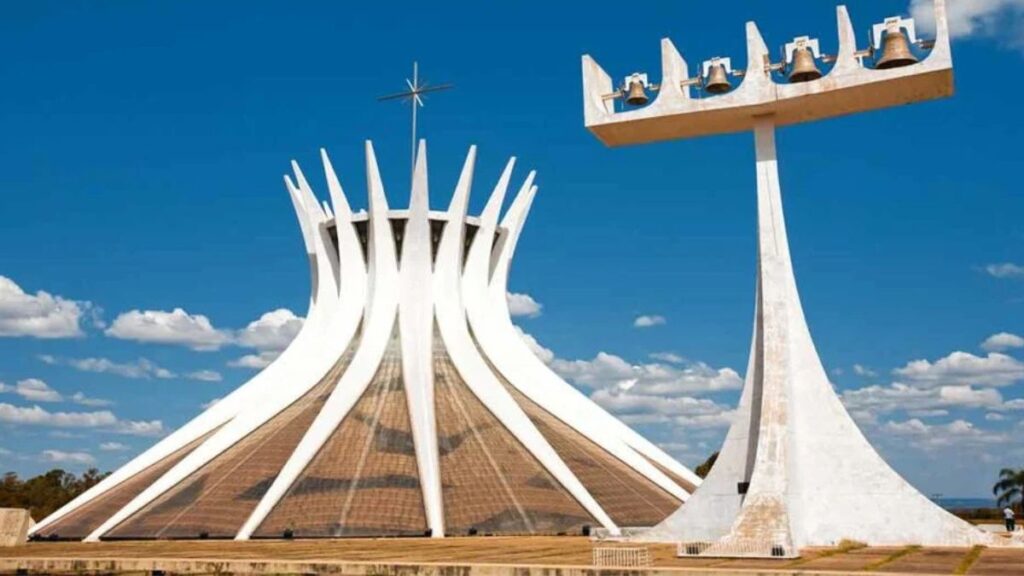Brazil is home to some of the world’s most iconic and striking architectural structures. From colonial-era buildings to modernist masterpieces, the country’s diverse architectural landscape showcases rich cultural heritage, artistic expression, and innovative design. In this article, we will delve into 3 famous buildings in brazil, which stand as symbols of the country’s vibrant history, culture, and progress. These structures not only highlight Brazil’s architectural evolution but also reflect the country’s unique approach to design, incorporating both indigenous and contemporary influences.
1. The Christ the Redeemer Statue (Cristo Redentor)
Overview
Perhaps Brazil’s most internationally recognized structure, the Christ the Redeemer statue stands atop Corcovado Mountain in Rio de Janeiro. This towering figure of Jesus Christ, with outstretched arms, overlooks the city and has become a global symbol of Christianity and Brazilian culture. In fact, it is one of the New Seven Wonders of the World.
History and Design
The statue was designed by Brazilian engineer Heitor da Silva Costa and French sculptor Paul Landowski. The construction of the monument began in 1926 and was completed in 1931. Standing at 98 feet tall, with arms stretching 92 feet, the figure was constructed using reinforced concrete and soapstone, chosen for its durability and weather resistance.
The Christ the Redeemer statue is not just a religious monument but a work of art, blending art deco and modernist styles. The face, hands, and robes are finely detailed, while the structure itself stands as an awe-inspiring architectural feat that balances artistic beauty with structural integrity.
Cultural and Religious Significance
The Christ the Redeemer statue represents peace and a welcoming gesture to visitors from around the world. It holds significant cultural and religious meaning, especially in the context of Brazil’s strong Christian traditions. The statue is a central pilgrimage site for thousands of people annually, drawing visitors from all corners of the globe who come to admire both its beauty and the breathtaking panoramic views of Rio de Janeiro it offers.
Modern-Day Relevance
In addition to its religious significance, the Christ the Redeemer statue has become an emblem of national pride and is one of the most visited tourist attractions in Brazil. Its presence in various films, documentaries. And international media has cemented its status as one of the world’s most recognizable monuments.
2. The National Congress of Brazil (Congresso Nacional do Brasil)
Overview
The National Congress of Brazil is located in Brasília, the country’s capital. It is one of the most important government buildings in Brazil, housing both the Senate and the Chamber of Deputies. The building is known for its modernist design and plays a pivotal role in Brazil’s political landscape.
History and Design
The National Congress was designed by the renowned Brazilian architect Oscar Niemeyer, who is famed for his avant-garde and futuristic approach to architecture. The construction of the National Congress was completed in 1960. Alongside the establishment of Brasília as the new capital city.
The building’s design is a masterpiece of modernist architecture. The two large domes—one concave (the Senate) and one convex (the Chamber of Deputies)—are among its most striking features. The structure is balanced and symmetrical, with elegant curves and sharp angles. The sleek lines of the building contrast with the surrounding landscape, creating a harmonious relationship between architecture and nature.
Cultural and Political Significance
The National Congress is not only a symbol of Brazil’s political power but also an embodiment of the country’s ambitious modernist vision. As Brasília was designed to be a futuristic city, the Congress building represents Brazil’s desire to move forward, embracing modernity and technological progress. It serves as a key representation of Brazil’s democratic process and its commitment to creating a forward-looking society.
Modern-Day Relevance
Today, the National Congress is a symbol of democracy and governmental transparency. The building hosts crucial political debates and decisions that affect millions of Brazilians. It is also a popular tourist attraction. Where visitors can take guided tours to learn more about Brazil’s political history and modern governance.
3. The São Paulo Museum of Art (Museu de Arte de São Paulo – MASP)
Overview
The São Paulo Museum of Art (MASP) is one of the most important cultural institutions in Brazil. Located on Paulista Avenue in São Paulo, MASP is known for its impressive collection of Western art. As well as its striking architecture. The building itself is as much a work of art as the collections it houses.
History and Design
MASP was originally founded in 1947 by philanthropist and art collector Assis Chateaubriand. The museum moved to its current location in 1968, when it was rebuilt by Italian-born architect Lina Bo Bardi. Bo Bardi’s design for MASP has become iconic due to its bold and innovative features.
The museum is elevated on two large lateral beams, creating a vast open space underneath the building. This modernist design allows for a wide public area, offering a stunning view of the city. The building’s transparent glass façade and use of concrete and steel contrast with the more traditional buildings around it. Making it stand out as a symbol of architectural and cultural progress.
Cultural Significance
MASP is an important center for both Brazilian and international art. Its collection includes works by famous artists such as Van Gogh, Picasso, and Rembrandt, as well as pieces by Brazilian artists who reflect the country’s cultural diversity and rich history. The museum serves as a cultural hub for São Paulo, hosting exhibitions, performances. And educational programs that engage the public in the arts.
Modern-Day Relevance
MASP remains one of the most visited art museums in Brazil and continues to be an important institution in the global art community. Its innovative architecture and world-class art collection draw visitors from around the world. Additionally, the museum’s design has influenced the development of other cultural institutions in Brazil and beyond.
Comparative Chart: Architectural Features of 3 Famous Buildings in Brazil
| Feature | Christ the Redeemer Statue | National Congress of Brazil | São Paulo Museum of Art (MASP) |
| Location | Rio de Janeiro, Corcovado | Brasília, Eixo Monumental | São Paulo, Paulista Avenue |
| Architect(s) | Heitor da Silva Costa, Paul Landowski | Oscar Niemeyer | Lina Bo Bardi |
| Style | Art Deco, Modernism | Modernism | Modernism |
| Completed | 1931 | 1960 | 1968 |
| Key Features | 98 ft statue, reinforced concrete, soapstone | Large domes, sleek lines, symmetrical | Elevated building, transparent glass, open public space |
| Cultural Significance | Religious, National Symbol | Political, Democratic Symbol | Artistic, Cultural Hub |
| Tourist Appeal | High (global icon) | Moderate (political interest) | High (art and architecture) |
Conclusion
Brazil’s architectural heritage is a testament to the country’s rich cultural diversity and its ever-evolving identity. The 3 famous buildings in Brazil—the Christ the Redeemer statue, the National Congress. And the São Paulo Museum of Art—represent different aspects of Brazilian life: religion, politics, and culture. Each building stands as a unique symbol of the nation’s journey through history, blending artistic creativity with technical innovation.
These structures are not only visually stunning but also embody Brazil’s aspirations and values. Making them must-see landmarks for anyone interested in exploring the country’s architectural and cultural landscape. Whether you are drawn to the monumental scale of Christ the Redeemer, the modernist vision of the National Congress, or the cultural richness housed within MASP, these three buildings offer a fascinating glimpse into Brazil’s past, present, and future.







